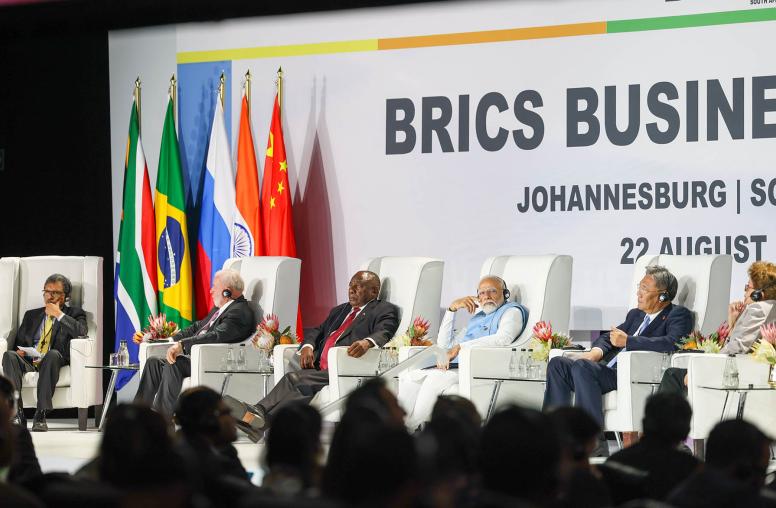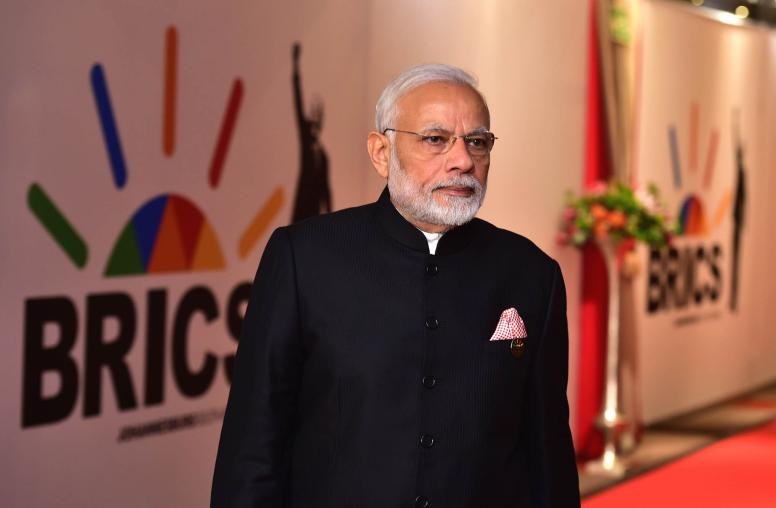As Tensions with India Grow, Maldives Looks to China
India-Maldives dispute over tourism threatens bilateral ties.
On January 4th, social media posts from Indian Prime Minister Narendra Modi praising the beauty of India’s beaches in Lakshadweep sparked a diplomatic row with the Indian Ocean island nation, Maldives. As a country that leans heavily on tourism at its own beaches, three Maldivian junior ministers were quick to criticize the Indian prime minister, which led to calls from Indian social media users to boycott Maldives as a tourist destination.

While on the surface the event may seem to be a minor social media rift, the exchange highlights tension between India and Maldives since the election of the new Maldivian president, Mohamed Muizzu, who has called for Indian troops to leave Maldives and for a more independent foreign policy, which would include improving ties with China.
USIP Visiting Expert Nilanthi Samaranayake analyzes what the latest dispute may indicate about India-Maldives ties since Muizzu’s election and the island nation’s relations with China and the United States.
What is the likely economic and diplomatic impact, if any, of Maldives’ current tensions with India?
The economic impact could be significant if Indian citizens choose to stay away from Maldives due to the ministers’ comments. In 2023, India was the top market supplying tourists to Maldives, but Indian citizens have other vacation options. The ministers’ comments were highly inappropriate for serving officials to make and unwise from a business standpoint, especially given Maldives’ economic dependence on tourism and the need to boost foreign exchange reserves for debt servicing.
But India could also see some adverse effects. Domestic observers have noted that most flights from India to Maldives are operated by Indian-owned airlines.
The diplomatic impact will be determined by officials from both countries. It is in the interest of both countries’ policymakers to demonstrate leadership by promptly resolving the dispute and not permitting it to derail bilateral relations for the next five years of President Mohamed Muizzu’s term.
Despite public outcry in India about the recent controversy, the Indian government has sought to maintain a positive relationship with Maldives as part of its “Neighborhood First” agenda. How does this incident — and a new, pro-China government more broadly — change India’s strategy to keep Maldives in its sphere of influence?
This incident was an unforced error on Maldives’ part at an already delicate time in bilateral relations. However, it is not clear that India has yet followed through on the intent of its Neighborhood First policy with the new administration.
The previous president, Ibrahim Mohamed Solih, emphasized putting “India first” in Maldives’ foreign policy. The public, however, has elected a leader from a different party who wants to diversify the country’s foreign policy options and assert more independence in the conduct of its security operations. At the same time, Muizzu stated early in his term that he still intends to keep a close relationship with India, even as his campaign pledge will result in the end of Maldives’ aerial security cooperation program with India. The president is challenging Maldives’ defense forces to build greater capacity in the conduct of its operations, which is expected to soon include hydrography. Muizzu decided in mid-December not to renew India’s hydrography security cooperation agreement with Maldives, which expires in June.
These recent developments reflect a striking shift in Maldives, given its defense policy over the past 15 years. While the change in leadership is often framed as a zero-sum, pro-China turn, the situation might be better understood as reflecting a smaller state’s discomfort with a renewed era of strategic competition, a desire to expand its range of partnerships and a climate of heightened nationalism. This will be an experiment as Maldives’ security forces will require greater capacity to conduct operations such as maritime surveillance, medical evacuation and hydrography on their own. In fact, it would not be surprising if Maldives eventually seeks a new security assistance package with India given its immense area of responsibility in the Indian Ocean. Muizzu has stated his desire for all countries to support Maldives’ defense requirements, which includes India and other partners such as the United States and Japan.
While the “India Out” campaign rhetoric was disheartening for New Delhi, diversification is a sentiment that India values in its own foreign policy and defense acquisition choices, and so Maldives’ desire for greater independence should be understandable. In fact, this altered situation counterintuitively could represent an opportunity for New Delhi to demonstrate how it can adapt its diplomacy and security cooperation under the policies of Neighborhood First and Security and Growth for All in the Region to a new political administration in a smaller South Asian neighbor.
It is not evident, however, that Indian officials are following through with Muizzu, post-campaign as president-elect and president, who has requested partnership with India on redefined terms. First, Minister of Earth Sciences Kiren Rijiju was dispatched to represent India at Muizzu’s inauguration in November, in contrast to Prime Minister Narendra Modi’s attendance at Solih’s 2018 inauguration. Second, as president-elect, Muizzu indicated his intent for India to be his first official trip abroad in keeping with tradition, but no concrete details have emerged about New Delhi’s receptivity to an early visit. Instead, Muizzu visited Turkey for his first official trip abroad in November and paid his first state visit to China in January.
Fortunately for bilateral relations, Modi and Muizzu were able to meet in early December on the sidelines of the COP28 summit in the United Arab Emirates. Their brief time together was productive in establishing a high-level core group to discuss areas of bilateral relations such as development cooperation and Maldives’ request that India withdraw its security personnel by March 15. This deadline is ahead of the election in parliament, in which the opposition Maldivian Democratic Party currently holds a majority. How promptly New Delhi welcomes Muizzu for a visit to India will serve as an indication not only of the trajectory of bilateral relations, but also of India’s willingness to adapt its Neighborhood First policy to support its strategic interests more broadly.
On January 10, Maldives signed several new agreements with China while President Mohamed Muizzu was in Beijing for his first state visit to China. What is the significance of this visit for the newly elected Maldivian government and how does Maldives-China bonhomie impact Maldives’ bilateral relationship with India?
China invited Muizzu for a state visit early in his term, and he accepted the invitation. Muizzu made a pitch for greater foreign direct investment (FDI), trade and tourism at the “Invest Maldives” forum in Fuzhou, China. Notably, he announced his administration’s intent to implement the Maldives-China Free Trade Agreement (FTA), which did not enter into force in the previous administration. The FTA was not mentioned in the Joint Press Communiqué between the two countries, but if realized, it will be a significant development in bilateral relations.
The list of key agreements signed between Maldives and China makes a reference to the Belt and Road Initiative (BRI). Muizzu is eager to expand Maldives’ main airport and develop a commercial port. He requested partnership under the auspices of the BRI. Still, the Muizzu administration would be wise to avoid taking on additional loans and will need Beijing’s cooperation to address Maldives’ significant debt to China. As an upper-middle-income economy, Maldives has seen its access to concessional loans diminish. Instead, it needs to focus on generating national income through tourism, trade and FDI, especially to boost its foreign exchange reserves.
Within India, this visit and the decision by the Muizzu administration to elevate Maldives-China bilateral relations to a comprehensive strategic cooperative partnership were seen as coming at India’s expense. Additionally, Indian observers are concerned by the implications of the 20 agreements signed between Maldives and China. They span a variety of cooperation areas such as tourism, fisheries, digital economy and disaster risk reduction.
On the other hand, Muizzu’s visit did not demonstrate cooperation with Beijing that would cross New Delhi’s security-related threat perceptions. For example, the key agreements signed did not indicate that the new administration plans to revisit the concerning protocol for a joint ocean observation station that was concluded by former President Abdulla Yameen [the founder of the India Out movement] but never implemented. On a related note, no indications of deepening defense ties with Maldives National Defence Force were evident from the visit, such as replacing India’s security presence with a Chinese one. Muizzu previously pledged to remove foreign military personnel from Maldives, “whether it’s India or any other country.” Beyond defense ties, the Joint Press Communiqué references cooperation on law enforcement that should be tracked for potential outcomes. Regardless, Indian policymakers and media will be sure to monitor any increase to the currently minimal level of security cooperation between Maldives and China.
What are the implications of Maldives ending its India First policy for U.S. strategy in the Indo-Pacific?
The United States does not appear to be involved in the difficult Maldives-India conversation and is focused on expanding its own relationship with Maldives. Samantha Power, the U.S. Agency for International Development (USAID) administrator, attended Muizzu’s inauguration and had a successful visit by all accounts on top of a positive year in the overall bilateral relationship. That said, U.S. policymakers would be wise to track developments in the Maldives-India relationship. The White House’s high-profile “Indo-Pacific Strategy” document from 2022 does not reference Maldives, but instead references India multiple times and discusses in its action plan how the United States will support India’s leadership in the region. This stance has implications for the U.S.-Maldives relationship if Maldives-India relations remain tense.
Despite the omission of Maldives from the “Indo-Pacific Strategy”document, the United States is active in its policy cooperation with Maldives in multiple areas. At this delicate stage in Maldives-India relations, Washington will want to monitor these ties and be alert for ways to be a helpful partner to both countries as it considers U.S. interests in the Indian Ocean and wider Indo-Pacific in 2024. More could be done to align U.S. policy toward Maldives with U.S. strategy toward the region in the next iteration of the “Indo-Pacific Strategy.”



